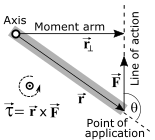Line of action
In physics, the line of action of a force F is a geometric representation of how the force is applied. It is the line through the point at which the force is applied in the same direction as the vector F→.[1][2]

The concept is essential, for instance, for understanding the net effect of multiple forces applied to a body. For example, if two forces of equal magnitude act upon a rigid body along the same line of action but in opposite directions, they cancel and have no net effect. But if, instead, their lines of action are not identical, but merely parallel, then their effect is to create a moment on the body, which tends to rotate it.
Calculation of torque
For the simple geometry associated with the figure, there are three equivalent equations for the magnitude of the torque associated with a force directed at displacement from the axis whenever the force is perpendicular to the axis:
where is the cross-product, is the component of perpendicular to , is the moment arm, and is the angle between and
References
-
- Kane, Thomas R.; Levinson, David A. (1985), Dynamics: Theory and Application, McGraw-Hill Series in Mechanical Engineering, McGraw-Hill, Inc., ISBN 0-07-037846-0
- Mungan, Carl E. "Acceleration of a pulled spool." The Physics Teacher 39.8 (2001): 481-485. https://www.usna.edu/Users/physics/mungan/_files/documents/Publications/TPT.pdf